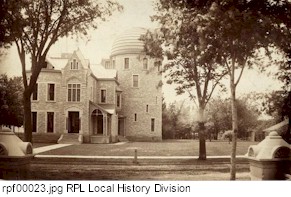
The Warner Observatory, by R.F. Bowdish, 1883
The Warner Observatory

The Warner Observatory, by R.F. Bowdish, 1883
The story of the Warner Observatory is largely the story of two men: a businessman and an astronomer.
Hulbert Harrington Warner (the businessman) moved to Rochester in 1870. He was a salesman for fireproof safes, but after his experience with a cure for an illness he contracted, he began to manufacture and sell a medicine product called Warner's Safe Liver Pills. He soon amassed a great fortune and began building his fantasy home on East Avenue at Goodman Street. While casting about for a way to use some of his money to support projects for the Rochester community, he happened to meet a local astronomer who had won gold medals from the Imperial Academy of Sciences in Vienna for his discovery of comets. This astronomer was Lewis Swift.
|
Left, a portrait of businessman H. H. Warner; right, a portrait of Lewis Swift
Lewis Swift was born in Clarkson, New York on February 29, 1820. Due to an accident at the age of 13, he underwent surgery which left him permanently lame. Unable to do farm work, he spent his time in studying. Although his condition eventually improved enough to allow him to return to work, his intellectual curiosity led him to continue to pursue many avenues of study, including astronomy. He became involved in the hardware store business as well, but astronomy remained his avocation.
After living in Cortland, New York, from 1854 until 1872, he returned to Rochester and opened a hardware store. Soon he was becoming known for sighting previously undiscovered comets. As his popularity increased, he began to give lectures on astronomy. "Professor" Swift, as he was known, began to receive funds designated for the building of a small observatory in Rochester.
This enterprise received a tremendous boost when H. H. Warner offered to build him a larger observatory costing $20,000 on condition the city would supply it with a 16-inch refractor telescope. Soon enough money was found to enable Swift to order a telescope from Alvan Clark and Son, a Massachusetts firm. Besides the telescope, the plans called for an astronomical library, other astronomy tools, an elevator and a residence for Professor Swift and his family.
By the time the telescope was installed in 1882, the entire project had cost H.H. Warner almost $100,000. Only three other telescopes in the country at the time exceeded the 2000 magnification power of the Swift telescope.
In Swift's book, History and Work of the Warner Observatory, he describes the observatory in his own words.
For several years, Professor Swift enjoyed his work at the observatory. His attentions turned from comets to nebulae. The observatory itself was the first observatory in the world to encourage visits by the general public. All a visitor had to do was buy a ticket (for 25 cents) at Warner's business on St. Paul Street. It became so well known that it was included in travel guidebooks.
Lewis Swift (on the stairs) with the telescope inside the Warner Observatory
Two main factors contributed to the loss of the observatory. One was the fact that it was becoming more difficult for Swift to observe the heavens in a city that was becoming more prosperous and more fully developed all the time. Also, the weather conditions in Rochester were not often conducive to stargazing. Swift began to explore other locales on the West Coast.
The second factor was a financial one: Warner was forced into bankruptcy in the depression of 1893. With the reversal of fortune of his main patron, Swift decided to pack up his telescope and leave for California, where he and his new benefactor, Professor Thaddeus S. C. Lowe, made plans for a new observatory on Echo Mountain. This observatory, where Swift worked for seven years, was the predecessor to the great observatory at nearby Mount Wilson. Failing eyesight prompted Swift's retirement in 1901. He died in 1913.
After Swift's departure from Rochester, the Warner Observatory was vacant. Then around 1901 Mr. and Mrs. A. Vernon Hart moved in. They operated the Vernon Academy of Mental Sciences and the Vernon Sanatorium until about 1909. The building was then vacant once again. In the 1920's the abandoned building was boarded up. In 1931 it was finally razed.
References
Rochester History 9 (No. 1), January 1947, Lewis Swift: The Rochester Astronomer, by Ralph Bates and Blake McKelvey
History and Work of the Warner Observatory, Rochester, N.Y., 1883-1886. Vol.1. Rochester, N.Y.: Warner Observatory [?] 1887.
Send comments to Webmaster
Copyright Monroe County (NY) Library System
115 South Ave., Rochester, NY 14604